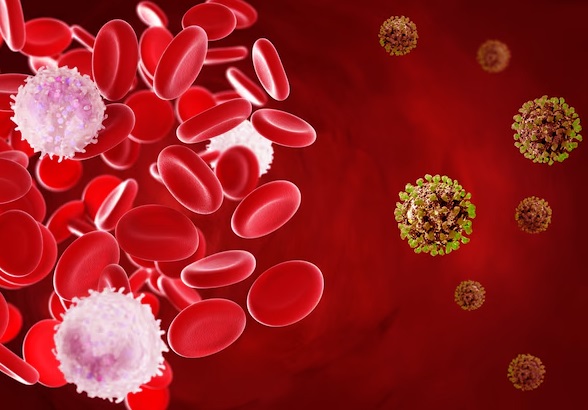COVID-19 Causes Elevation of Hepcidin Levels, Disrupts Erythropoiesis, Induces Inflammation, and Alters Iron Metabolism
Nikhil Prasad Fact checked by:Thailand Medical News Team Jan 21, 2025 2 months, 1 week, 5 days, 21 hours, 9 minutes ago
Medical News: The global COVID-19 pandemic, caused by the SARS-CoV-2 virus, has revealed a myriad of complications beyond respiratory issues, delving deep into the realm of hematological disruptions. A recent study, conducted by Italian researchers from the Department of Medicine and Surgery at the University of Parma and the University of Pavia, sheds light on the intricate pathways by which COVID-19 affects iron metabolism, erythropoiesis (red blood cell production), inflammation, and hepcidin regulation.
 COVID-19 Causes Elevation of Hepcidin Levels, Disrupts Erythropoiesis, Induces Inflammation, and Alters Iron Metabolism
Understanding the Complex Interplay of Infection and Blood Dynamics
COVID-19 Causes Elevation of Hepcidin Levels, Disrupts Erythropoiesis, Induces Inflammation, and Alters Iron Metabolism
Understanding the Complex Interplay of Infection and Blood Dynamics
Severe acute respiratory syndrome coronavirus 2 (SARS-CoV-2) has been linked to profound disruptions in the body’s hematopoietic system. It alters red blood cell (RBC) production, promotes inflammation, and creates an imbalance in iron metabolism. This
Medical News report explores these findings, revealing how COVID-19’s impact extends far beyond the lungs.
Key to these findings is the role of hepcidin, a liver-produced hormone that regulates iron levels by controlling its storage and release. In COVID-19 patients, inflammation and hypoxia - a lack of sufficient oxygen in the blood - drive up hepcidin levels. Elevated hepcidin limits iron availability in the bloodstream by trapping it in storage sites, disrupting the delicate balance required for effective erythropoiesis. This results in a condition known as functional iron deficiency, even when iron stores are adequate or elevated.
Hepcidin: The Iron Gatekeeper
Hepcidin is a crucial regulator in maintaining iron homeostasis. During infections, its levels typically rise to restrict iron access to pathogens. However, in COVID-19, this protective mechanism backfires. The study reveals that the elevated hepcidin levels in patients correlate with hypoferremia (low serum iron levels), which in turn impairs hemoglobin synthesis and RBC production. This disruption is exacerbated by suppressed erythroferrone (ERFE) levels, a hormone produced in the bone marrow that normally inhibits hepcidin to ensure sufficient iron for erythropoiesis.
The Cytokine Storm and Its Role in Inflammation
COVID-19 often triggers a cytokine storm, marked by the excessive release of pro-inflammatory molecules such as interleukin-6 (IL-6). This storm plays a central role in the elevated hepcidin levels observed in patients. IL-6 directly stimulates hepcidin production, creating a vicious cycle of inflammation and iron dysregulation. Furthermore, other cytokines, including tumor necrosis factor-alpha (TNF-α) and interferon-gamma (IFN-γ), inhibit erythropoiesis by inducing apoptosis (programmed cell death) in erythroid progenitor cells in the bone marrow.
Erythropoiesis Under Siege
The study also highlights significant abnormalities in erythropoiesis among COVID-19 patients. Lower le
vels of erythropoietin (EPO), the hormone that drives RBC production, were observed. Inflammatory cytokines such as IL-6 and TNF-α suppress EPO production in the kidneys, leading to reduced stimulation of bone marrow erythropoiesis. Additionally, SARS-CoV-2 directly invades bone marrow progenitor cells, further impairing their ability to produce mature RBCs.
The Role of Hypoxia
Hypoxia, a hallmark of severe COVID-19 cases, compounds these effects. As oxygen levels drop, the body’s natural response is to boost erythropoiesis to enhance oxygen delivery. However, in COVID-19 patients, this compensatory mechanism is overridden by the inflammatory response. Despite hypoxia-driven signals to suppress hepcidin and increase iron availability, the inflammatory milieu dominates, keeping hepcidin levels elevated and iron locked away in stores.
Morphological Changes in Red Blood Cells
Beyond production issues, COVID-19 also induces morphological changes in RBCs. Spiculated cells, such as echinocytes and acanthocytes, are frequently observed, reflecting membrane alterations. These changes impair RBC’s oxygen-carrying capacity, contributing to symptoms like fatigue and exacerbating hypoxia.
Disrupted Iron Metabolism
The study emphasizes how COVID-19 alters iron metabolism, a critical factor in the body’s ability to fight infections and maintain health. High ferritin levels, often seen in patients, do not indicate sufficient iron availability but rather reflect inflammation and iron sequestration in cells. This “iron paradox” explains why patients with high ferritin can still exhibit signs of iron deficiency anemia.
Key Findings from the Study
-Hepcidin Elevation: Hepcidin levels were significantly higher in patients with severe COVID-19 compared to non-severe cases, correlating with low serum iron and increased inflammation.
-Cytokine Impact: High levels of IL-6, TNF-α, and IFN-γ disrupted normal erythropoiesis and iron metabolism.
-RBC Abnormalities: Morphological changes and reduced hemoglobin levels impaired oxygen transport.
-Strain Variations: The study noted that the original Wuhan strain of SARS-CoV-2 had a more pronounced impact on erythropoiesis compared to Delta and Omicron variants.
Implications for Treatment
Addressing these hematological complications is critical for improving COVID-19 outcomes. Potential therapeutic strategies include:
-Hepcidin Modulation: Drugs targeting hepcidin regulation may restore iron balance and improve anemia.
-Anti-Inflammatory Therapies: Medications like tocilizumab, which block IL-6, could reduce inflammation-driven hepcidin elevation.
-
EPO Therapy: In severe cases, erythropoietin analogs may support RBC production and counteract anemia.
Conclusion
COVID-19 has unveiled a complex interplay between inflammation, iron metabolism, and erythropoiesis. Elevated hepcidin levels, driven by cytokine storms and hypoxia, disrupt iron homeostasis and impair RBC production. These hematological disruptions contribute to the disease’s severity and highlight the need for targeted interventions. By understanding these mechanisms, researchers and clinicians can develop strategies to mitigate the systemic effects of COVID-19 and improve patient outcomes.
The study findings were published in the peer-reviewed International Journal of Molecular Sciences.
https://www.mdpi.com/1422-0067/26/3/874
For the latest COVID-19 News, keep on logging to Thailand
Medical News.
Read Also:
https://www.thailandmedical.news/news/breaking-covid-19-news-iron-sulfur-cluster-proteins-found-in-viruses-including-sars-cov-2-that-possibly-contributes-to-pathogenesis
https://www.thailandmedical.news/news/higher-dietary-iron-and-zinc-intake-are-associated-with-decreased-risk-of-covid-19-infection-and-hospitalization
https://www.thailandmedical.news/news/covid-19-news-study-validates-that-sars-cov-2-structural-proteins-binds-to-hemoglobin-and-myoglobin-causing-hemoglobin-and-iron-dysmetabolism
https://www.thailandmedical.news/articles/coronavirus
